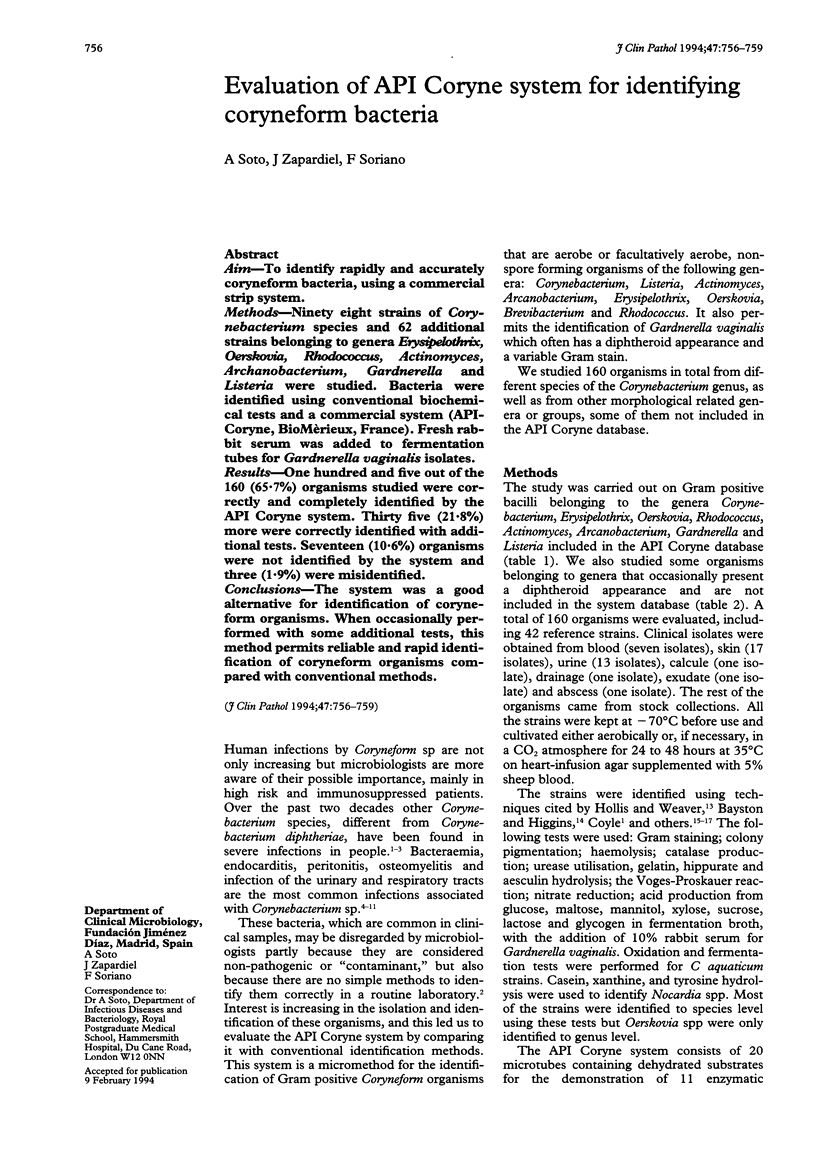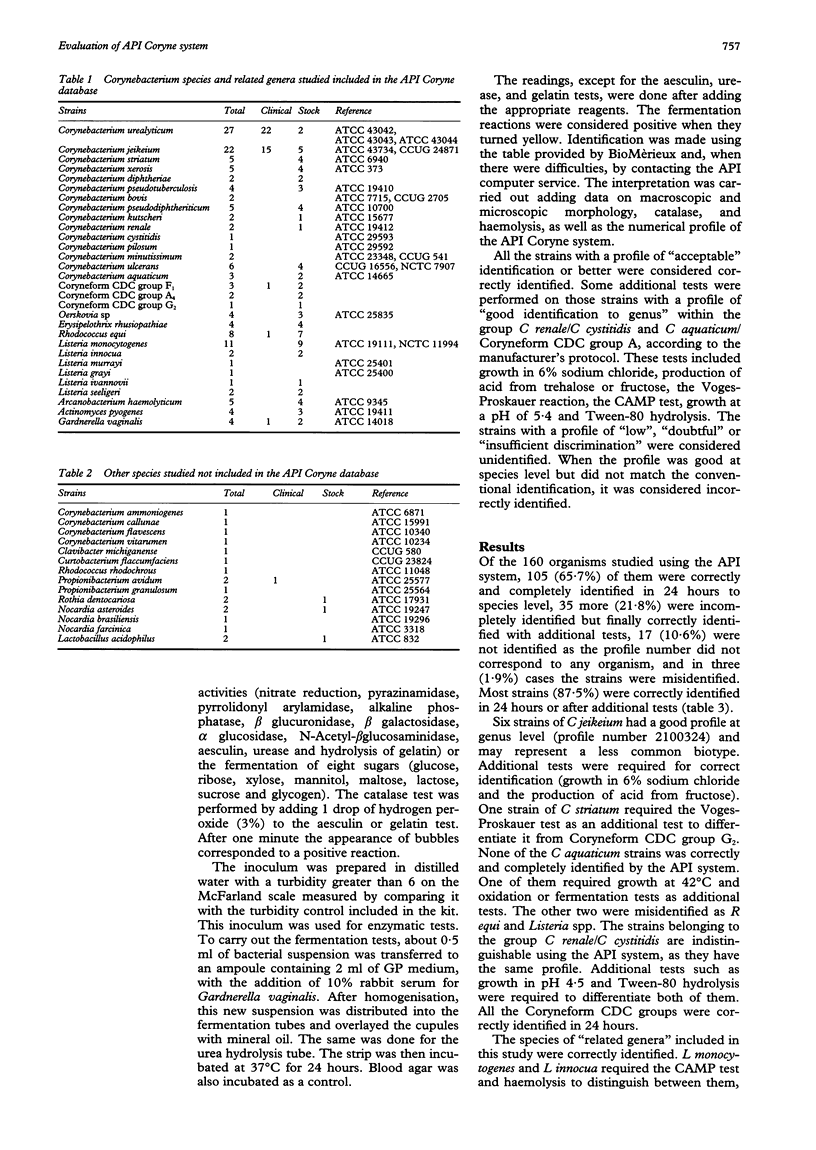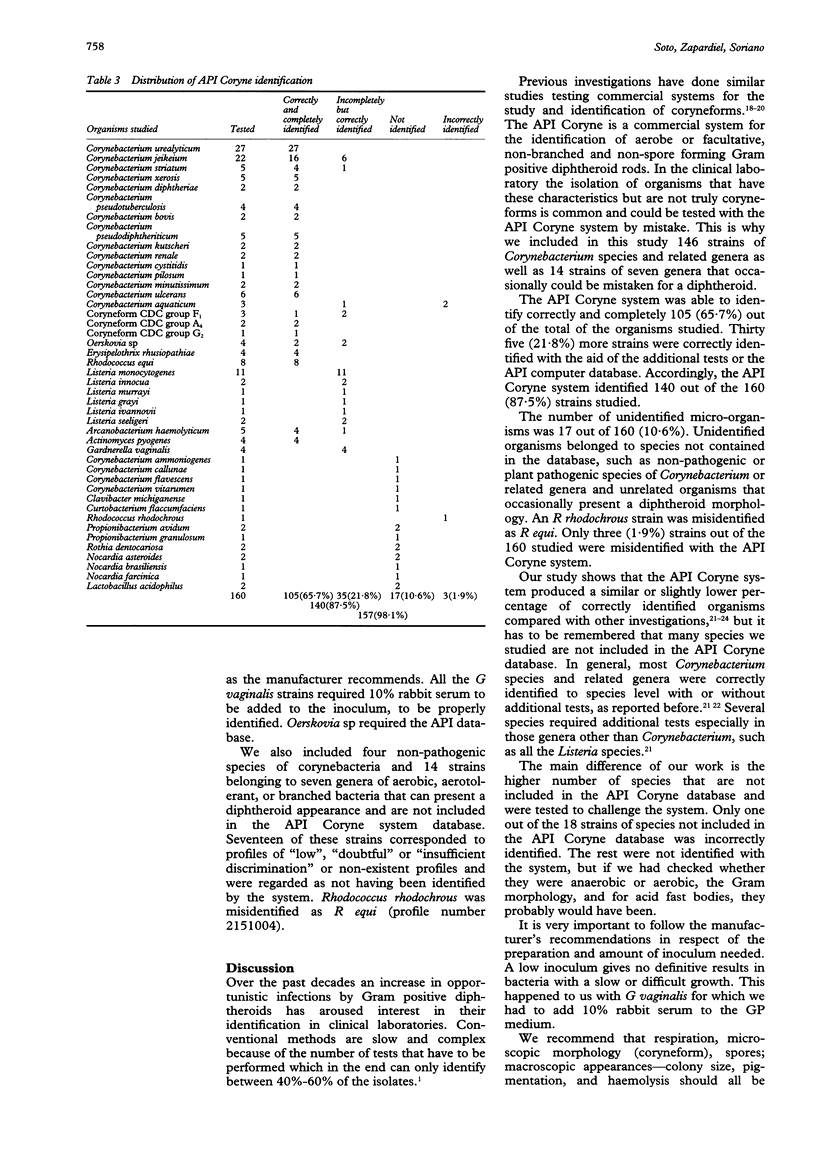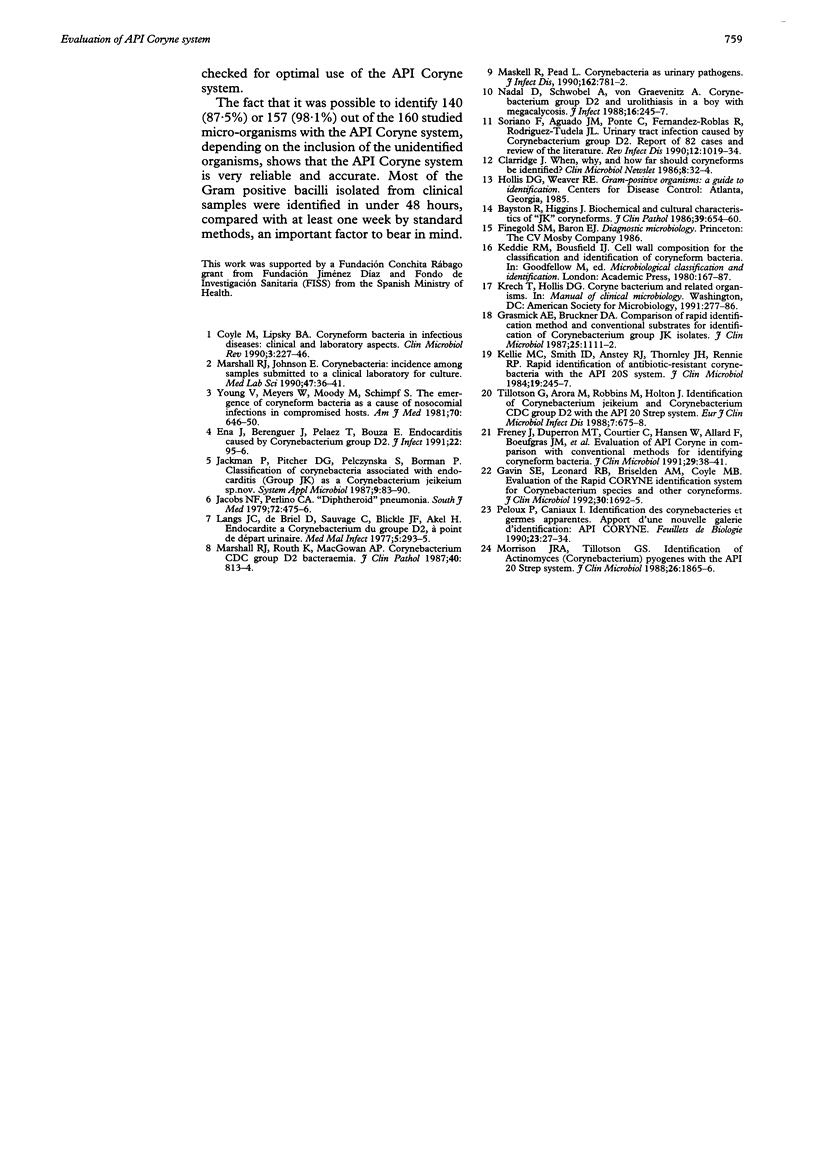Abstract
AIM--To identify rapidly and accurately coryneform bacteria, using a commercial strip system. METHODS--Ninety eight strains of Corynebacterium species and 62 additional strains belonging to genera Erysipelothrix, Oerskovia, Rhodococcus, Actinomyces, Archanobacterium, Gardnerella and Listeria were studied. Bacteria were identified using conventional biochemical tests and a commercial system (API-Coryne, BioMèrieux, France). Fresh rabbit serum was added to fermentation tubes for Gardnerella vaginalis isolates. RESULTS--One hundred and five out of the 160 (65.7%) organisms studied were correctly and completely identified by the API Coryne system. Thirty five (21.8%) more were correctly identified with additional tests. Seventeen (10.6%) organisms were not identified by the system and three (1.9%) were misidentified. CONCLUSIONS--The system was a good alternative for identification of coryneform organisms. When occasionally performed with some additional tests, this method permits reliable and rapid identification of coryneform organisms compared with conventional methods.
Full text
PDF



Selected References
These references are in PubMed. This may not be the complete list of references from this article.
- Bayston R., Higgins J. Biochemical and cultural characteristics of "JK" coryneforms. J Clin Pathol. 1986 Jun;39(6):654–660. doi: 10.1136/jcp.39.6.654. [DOI] [PMC free article] [PubMed] [Google Scholar]
- Coyle M. B., Lipsky B. A. Coryneform bacteria in infectious diseases: clinical and laboratory aspects. Clin Microbiol Rev. 1990 Jul;3(3):227–246. doi: 10.1128/cmr.3.3.227. [DOI] [PMC free article] [PubMed] [Google Scholar]
- Ena J., Berenguer J., Peláez T., Bouza E. Endocarditis caused by Corynebacterium group D2. J Infect. 1991 Jan;22(1):95–96. doi: 10.1016/0163-4453(91)91150-v. [DOI] [PubMed] [Google Scholar]
- Freney J., Duperron M. T., Courtier C., Hansen W., Allard F., Boeufgras J. M., Monget D., Fleurette J. Evaluation of API Coryne in comparison with conventional methods for identifying coryneform bacteria. J Clin Microbiol. 1991 Jan;29(1):38–41. doi: 10.1128/jcm.29.1.38-41.1991. [DOI] [PMC free article] [PubMed] [Google Scholar]
- Gavin S. E., Leonard R. B., Briselden A. M., Coyle M. B. Evaluation of the rapid CORYNE identification system for Corynebacterium species and other coryneforms. J Clin Microbiol. 1992 Jul;30(7):1692–1695. doi: 10.1128/jcm.30.7.1692-1695.1992. [DOI] [PMC free article] [PubMed] [Google Scholar]
- Grasmick A. E., Bruckner D. A. Comparison of rapid identification method and conventional substrates for identification of Corynebacterium group JK isolates. J Clin Microbiol. 1987 Jun;25(6):1111–1112. doi: 10.1128/jcm.25.6.1111-1112.1987. [DOI] [PMC free article] [PubMed] [Google Scholar]
- Jacobs N. F., Jr, Perlino C. A. "Diphtheroid" pneumonia. South Med J. 1979 Apr;72(4):475–476. doi: 10.1097/00007611-197904000-00026. [DOI] [PubMed] [Google Scholar]
- Keddie R. M., Bousfield I. J. Cell wall composition in the classification and identification of coryneform bacteria. Soc Appl Bacteriol Symp Ser. 1980;8:167–188. [PubMed] [Google Scholar]
- Kelly M. C., Smith I. D., Anstey R. J., Thornley J. H., Rennie R. P. Rapid identification of antibiotic-resistant corynebacteria with the API 20S system. J Clin Microbiol. 1984 Feb;19(2):245–247. doi: 10.1128/jcm.19.2.245-247.1984. [DOI] [PMC free article] [PubMed] [Google Scholar]
- Marshall R. J., Johnson E. Corynebacteria: incidence among samples submitted to a clinical laboratory for culture. Med Lab Sci. 1990 Jan;47(1):36–41. [PubMed] [Google Scholar]
- Marshall R. J., Routh K. R., MacGowan A. P. Corynebacterium CDC group D2 bacteraemia. J Clin Pathol. 1987 Jul;40(7):813–814. doi: 10.1136/jcp.40.7.813-c. [DOI] [PMC free article] [PubMed] [Google Scholar]
- Maskell R., Pead L. Corynebacteria as urinary pathogens. J Infect Dis. 1990 Sep;162(3):781–782. doi: 10.1093/infdis/162.3.781. [DOI] [PubMed] [Google Scholar]
- Morrison J. R., Tillotson G. S. Identification of Actinomyces (Corynebacterium) pyogenes with the API 20 Strep system. J Clin Microbiol. 1988 Sep;26(9):1865–1866. doi: 10.1128/jcm.26.9.1865-1866.1988. [DOI] [PMC free article] [PubMed] [Google Scholar]
- Nadal D., Schwöbel M., von Graevenitz A. Corynebacterium group D2 and urolithiasis in a boy with megacalycosis. Infection. 1988 Jul-Aug;16(4):245–247. doi: 10.1007/BF01650763. [DOI] [PubMed] [Google Scholar]
- Soriano F., Aguado J. M., Ponte C., Fernández-Roblas R., Rodríguez-Tudela J. L. Urinary tract infection caused by Corynebacterium group D2: report of 82 cases and review. Rev Infect Dis. 1990 Nov-Dec;12(6):1019–1034. doi: 10.1093/clinids/12.6.1019. [DOI] [PubMed] [Google Scholar]
- Tillotson G., Arora M., Robbins M., Holton J. Identification of Corynebacterium jeikeium and Corynebacterium CDC group D2 with the API 20 Strep system. Eur J Clin Microbiol Infect Dis. 1988 Oct;7(5):675–678. doi: 10.1007/BF01964252. [DOI] [PubMed] [Google Scholar]
- Young V. M., Meyers W. F., Moody M. R., Schimpff S. C. The emergence of coryneform bacteria as a cause of nosocomial infections in compromised hosts. Am J Med. 1981 Mar;70(3):646–650. doi: 10.1016/0002-9343(81)90589-1. [DOI] [PubMed] [Google Scholar]


